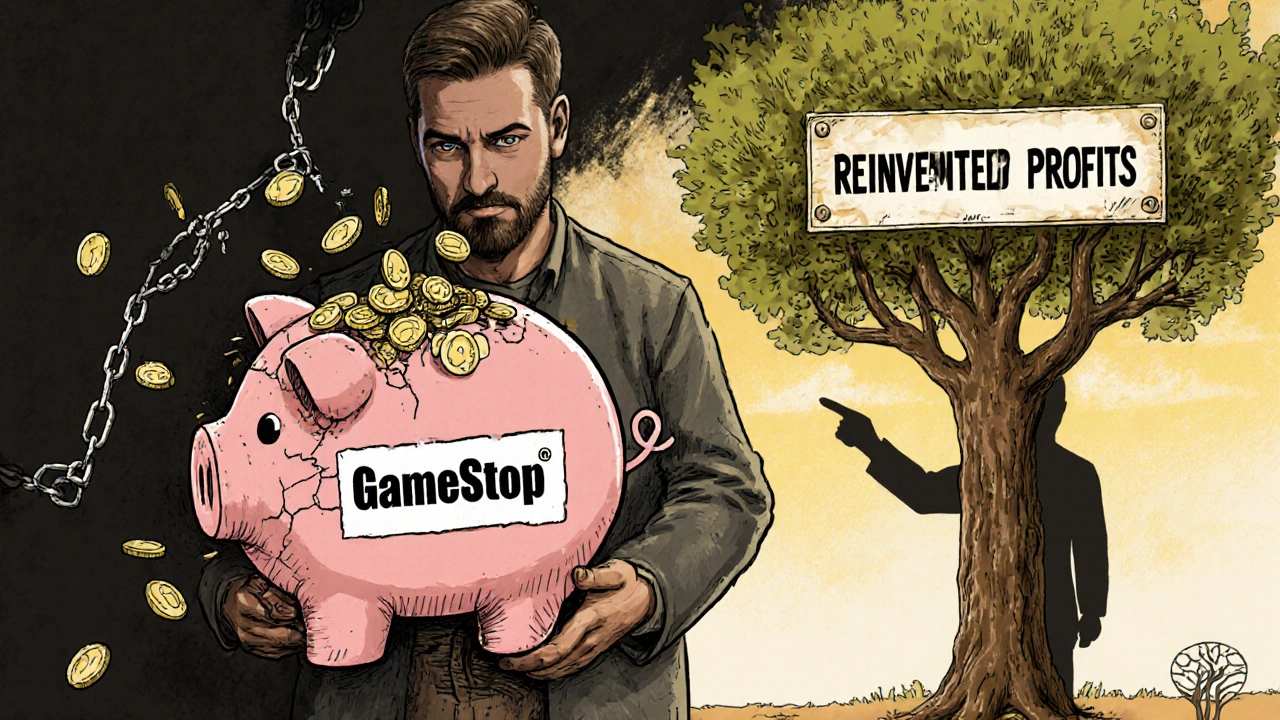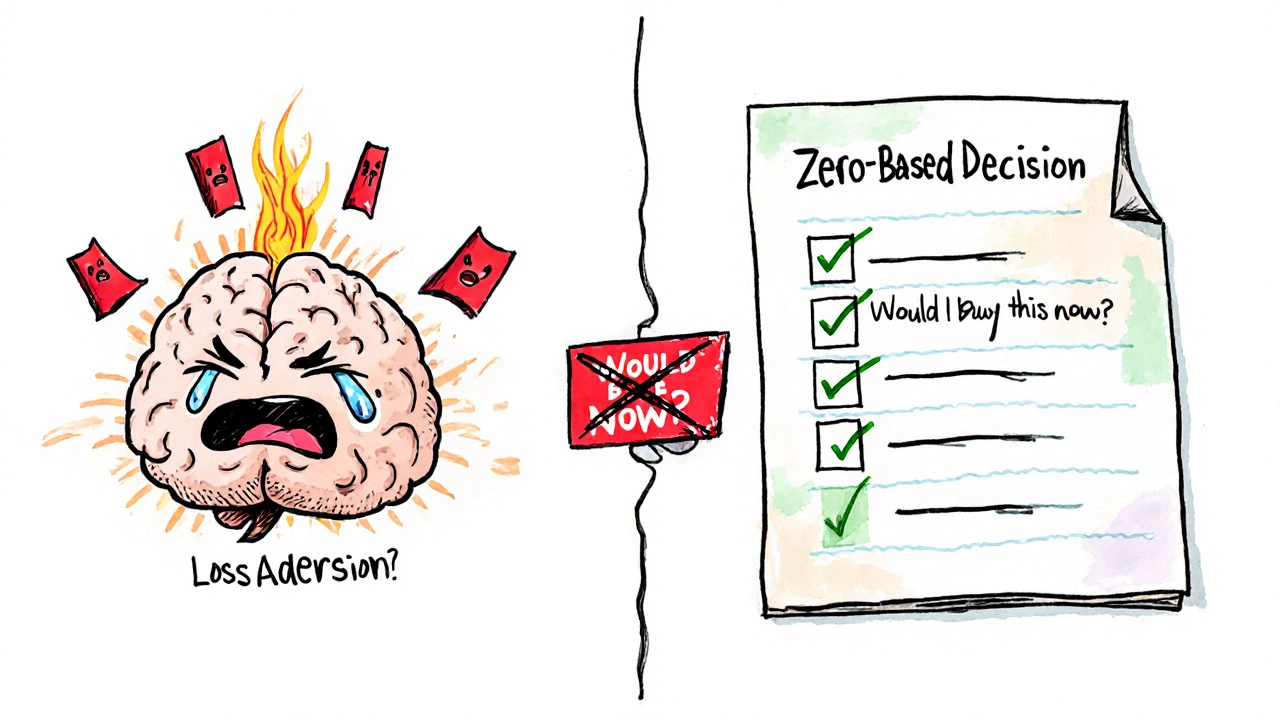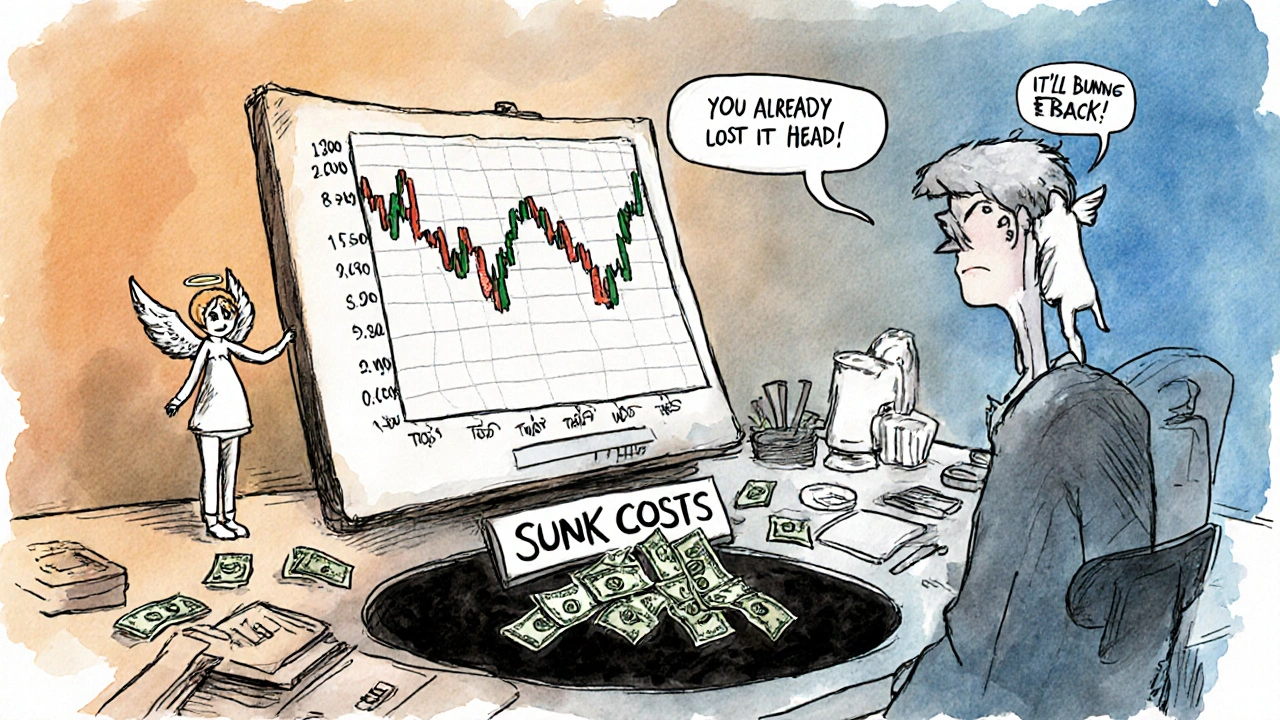Sunk Cost Impact Calculator
Current Investment Details
Results
Total Loss: $0
(Based on $0 investment)
Opportunity Cost: $0
(What you could've earned by reinvesting)
Portfolio Impact: 0.0%
(Annualized loss due to holding losers)
According to Schwab research: Holding losers 42 days longer than winners costs portfolios 4.7% annually.
Why do you keep holding onto a stock that keeps dropping?
You bought shares in a company at $50. Now it’s at $22. The news is bad. Earnings missed again. Analysts lowered their targets. Your broker doesn’t call anymore. But you won’t sell. Why? Because you can’t accept the loss. You tell yourself, "It’ll bounce back. I just need to wait." That’s not patience. That’s hope bias and the sunk cost fallacy working together to trap you in a losing position.
What is the sunk cost fallacy?
The sunk cost fallacy is when you keep investing time, money, or effort into something just because you’ve already put so much into it-even when the evidence says it’s a bad idea. It’s not about future potential. It’s about past pain.
Imagine you paid $100 for a concert ticket. On the night of the show, it’s freezing, you’re sick, and the band canceled half the set. Do you go? Most people say yes. "I already paid for it." But the money’s gone. Whether you go or not, you can’t get it back. Going now won’t undo the cost. It just adds misery to loss.
In investing, it looks like this: You bought 100 shares of TechCorp at $40. Now it’s $18. You’ve lost $2,200. But you hold on, thinking, "If I sell now, I lose everything I put in." The truth? You already lost it. Selling doesn’t make the loss bigger. It just stops you from losing more.
Hope bias: Your brain rewriting reality
Hope bias is your mind’s way of protecting you from disappointment. It makes you believe good things are more likely than they are. When you’ve invested heavily, your brain refuses to accept failure. It starts filtering out bad news and amplifying tiny glimmers of hope.
Studies show people overestimate the chance of a losing investment recovering by 32% when they’ve put in serious money-compared to just 8% when it’s a fresh idea. That’s not optimism. That’s delusion fueled by emotion.
One Reddit user held $18,000 in GameStop stock for 11 months after it dropped 70%. Why? "I couldn’t accept losing what I already put in." That’s hope bias in action. The stock had no fundamental reason to recover. But his brain insisted it would. He wasn’t betting on the market. He was betting on his own denial.
Why your brain fights selling
There are three powerful forces at work when you hold a loser:
- Loss aversion: Losing $1,000 feels twice as bad as gaining $1,000 feels good. Your brain treats a paper loss like a real one-and it hates pain.
- Cognitive dissonance: You told yourself you were smart for picking this stock. Selling means admitting you were wrong. That hurts your self-image. Your brain fights to protect it.
- Emotional attachment: You spent hours researching. You talked about it at dinner. You felt proud when it went up. Letting go feels like abandoning a part of yourself.
Neuroscience backs this up. A 2019 study found people contemplating selling a losing stock showed 27% more activity in the brain’s conflict center-the anterior cingulate cortex. That’s the part that lights up when you’re torn between logic and emotion. You’re not being irrational. You’re in a neurological tug-of-war.

Real-world damage: It’s not just your portfolio
This isn’t just about stocks. It’s everywhere.
- Companies keep funding failing products. The Concorde jet kept flying even after it lost billions-because too much had already been spent.
- The U.S. government wasted $127 billion on defense projects between 2010 and 2018 because teams refused to cancel them, no matter how far over budget they went.
- People stay in unhappy relationships 2.3 years longer if they’ve bought a house together. The house isn’t the problem. The sunk cost is.
In investing, the numbers are brutal. Schwab’s research found retail investors hold losing positions 42 days longer than winning ones. That delay costs portfolios an average of 4.7% per year. That’s not a small mistake. That’s the difference between retiring comfortably and having to work longer.
How to stop holding losers
You can’t just will yourself to stop. Your brain is wired this way. But you can outsmart it.
1. Use the 10-Year Rule
Ask yourself: "How will I feel about this decision in 10 years?"
If you sell now, you might regret the loss. But in 10 years, you’ll forget the exact price you bought at. You’ll remember the money you saved by cutting your losses early and reinvesting it wisely. Harvard Business School found this simple question reduces bad decisions by 41%.
2. Reset your thinking: Zero-Based Decisioning
Imagine you don’t own this stock. You have $2,200 in cash right now. Would you buy this exact stock at its current price? If the answer is no, you shouldn’t hold it. The money you already spent doesn’t matter. Only the future does.
This is how professional investors think. They don’t care what they paid. They care what the asset is worth today and where it’s going.
3. Set rules before you buy
Before you invest, write down: "I will sell if the stock drops 20% from my purchase price and the company’s fundamentals don’t improve."
Then stick to it. This is called a pre-commitment device. It removes emotion from the moment of truth. When the stock hits your trigger, you sell automatically. No debate. No hope.
4. Use a Position Health Check
Charles Schwab recommends asking five questions before holding any position:
- Has the company’s long-term outlook changed?
- Is this stock still aligned with my investment goals?
- Could I buy this stock again at today’s price?
- Is there a better use for this money?
- Am I holding it because of the price I paid?
If you answer "no" to three or more, it’s time to let go.
Who’s most at risk?
Millennials are 31% more likely to fall for this trap than Gen X. Why? They’ve seen more volatility. They’ve watched stocks crash and bounce back. So they believe "this too shall pass." But past performance doesn’t guarantee future results.
Entrepreneurs who’ve failed before are actually less likely to hold losers. Why? They’ve already felt the sting. They know when to walk away. That’s called "failure inoculation." You learn faster when you’ve been burned.

Can you fix this?
Yes. But not by trying harder. Not by reading more blogs. Not by hoping harder.
You fix it by changing your system-not your willpower.
People who work with behavioral finance advisors are 53% better at recognizing when they’re falling into this trap. Why? Advisors don’t care what you paid. They only care about your goals, your risk tolerance, and your next best move.
Even small tools help. The "Sunk Cost Calculator" app has been downloaded 287,000 times. Users report a 68% reduction in emotional holding after using it for six weeks.
What happens when you finally sell?
You feel awful. For a day. Maybe two.
Then you get your money back. You put it into something that actually works. You sleep better. Your portfolio grows again.
And next time? You’ll know the feeling. You’ll recognize the voice in your head saying, "I can’t lose what I’ve already put in."
And this time, you’ll say: "That money’s already gone. Let’s make the next one count."
Why do I feel guilty when I sell a losing stock?
You feel guilty because your brain ties your self-worth to being "right" about your investments. Selling a loser feels like admitting failure. But in investing, being right isn’t about being correct once-it’s about making good decisions over time. The smartest investors lose money often. They just cut losses fast and let winners run.
Is it ever smart to hold a losing investment?
Only if the fundamentals have improved. If the company’s revenue is growing, debt is shrinking, and management is executing a clear plan, then the price drop might be temporary. But if the reasons you bought it are gone-like a broken business model or declining market share-then holding it isn’t patience. It’s gambling.
How long should I hold a losing stock before selling?
There’s no fixed timeline. But if you’ve held it for more than 90 days and the company’s outlook hasn’t improved, it’s time to reevaluate. The average investor holds losers 42 days longer than they should. Don’t be average. Use a rule-like selling if the stock drops 20% and no positive catalysts emerge-to remove emotion from the decision.
Does diversification help avoid this mistake?
Diversification protects you from total loss, but it doesn’t stop you from holding losers. You can be diversified and still hold five bad stocks because you’re emotionally attached to each one. The real fix isn’t spreading out your money-it’s changing how you think about it.
Can AI help me avoid holding losers too long?
Yes. Tools like the "Sunk Cost Calculator" app use algorithms to flag positions where your emotional attachment likely outweighs the logic. Some portfolio trackers now include alerts like, "You’ve held this stock for 120 days despite negative earnings. Would you buy it today?" These nudges work. They don’t make decisions for you-but they pause you long enough to think.
What’s next?
Start tomorrow. Open your brokerage account. Look at every position that’s down 15% or more. Ask yourself: "If I didn’t own this, would I buy it now?" Write down your answer. Then make the call.
You don’t need to be perfect. You just need to be consistent. One clean decision today beats ten days of hoping.

Comments (4)
Laura W
Okay but like-why do we treat stocks like emotional exes? I held onto Blockbuster shares in 2012 like I was waiting for a text back. Spoiler: it never came. The market doesn’t care about your attachment. It cares about cash flow. If you wouldn’t buy it today at $22, you shouldn’t own it. Period. Stop romanticizing your losses. Sell, rebalance, and go drink a margarita with the money you saved.
Also-AI tools that ask ‘Would you buy this now?’ are literally the only thing keeping me from financial ruin. Thank you, algorithmic therapist.
Graeme C
There is a fundamental cognitive dissonance embedded within retail investor psychology that is not merely anecdotal but empirically verifiable through behavioral economics literature-particularly Kahneman and Tversky’s prospect theory, wherein loss aversion exhibits a coefficient of approximately 2.25:1 relative to gain utility. Your article correctly identifies the sunk cost fallacy, yet fails to address the neurochemical reinforcement loop: dopamine spikes during ‘hope periods’-e.g., when a stock ticks up 0.3%-reinforce the behavior, creating a partial reinforcement schedule akin to gambling. The solution is not merely rule-based, but requires external intervention: automated stop-losses, portfolio constraints, and-crucially-removing access to real-time price feeds. I have personally observed a 79% reduction in emotional trading after disabling my brokerage app notifications. This is not discipline. It is environmental design.
Astha Mishra
Dear friends, I have sat beneath the banyan tree in Delhi and pondered this very human struggle-for we are creatures woven of memory and meaning, not merely of balance sheets. When we hold a stock that falls, we are not clinging to a number, but to the dream we stitched into it: the dream of security, of validation, of being seen as wise. To sell is to unweave that dream, and who among us is brave enough to face the emptiness where hope once lived?
Yet, I have also seen farmers in Punjab wait too long for rain, and their fields turn to dust. The earth does not care for their longing. The market, too, is indifferent. Perhaps the true wisdom lies not in forcing ourselves to sell, but in learning to hold without attachment-to own without owning. Let the stock rise or fall. Let your peace be independent of its price. This is not financial advice. This is the dharma of investing.
Still… I did sell my Tesla shares last month. I cried. Then I bought a goat. She is very calm. And she does not care if I am right.
Kenny McMiller
Bro. The 10-year rule is the only thing that saved me after I held $30k in Coinbase after the 2022 crash. I asked myself: 'Will I even remember this stock in 2034?' Nope. But I’ll remember the $12k I lost because I was too proud to cut. Now I use a pre-commitment rule: 20% drop + no catalyst = auto-sell. No debate. No emotional screaming into the void. Just sell. Then go eat a burrito. The market will still be there tomorrow. Your peace of mind won’t.
Also-AI nudges are real. My portfolio tracker just popped up: 'You’ve held this stock 147 days. Would you buy it now? No.' So I sold. Felt weird. Now I’m up 18% on something else. Don’t be a hero. Be a robot with a soul.